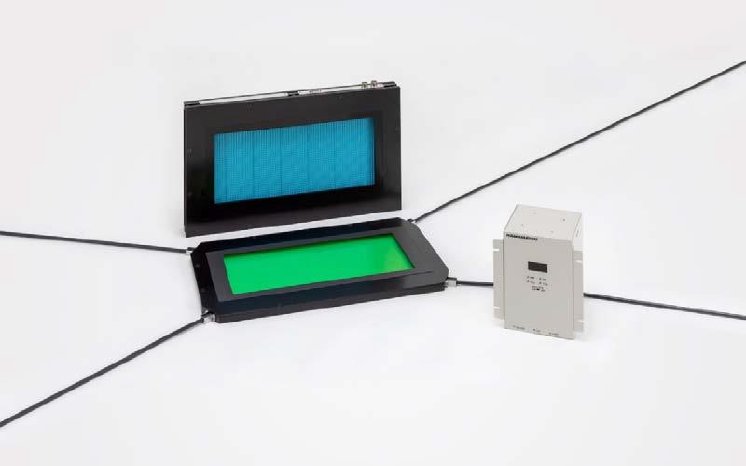This product will be on display at the world’s largest exhibition ”The 11th International Rechargeable Battery Expo (Battery Japan)” held in Tokyo Big Sight (Koto-ku, Tokyo, Japan) for 3 days from Wednesday, February 26th to Friday, February 28th, 2020.
Product overview
This product is an optical pinhole inspection unit that detects pinhole defects as small as 1 μm in diameter in large sheet workpieces and does all this quickly in just a single unit. In optical inspections, the light source irradiates light onto a workpiece and any light passing though pinholes is efficiently collected and detected by this inspection unit as electrical signals by the built-in photomultiplier tube which is a highly sensitive photodetector and allows detecting any tiny pinhole defects in the workpiece. Other inspection methods rely on fluids or gases for detecting pinholes but the optical method applies no actual physical pressure to the workpiece during inspection.
The tinier the pinhole defect, the lower the intensity of the light passing through the pinhole. This reduces the detectable light signal and so makes it hard to find tiny pinholes. Using an amplifier circuit can boost the signal but also raises the noise level in the signal. Along with using an amplifier circuit to boost the signal level, we revamped the circuit design and employed a lock-in amplifier for signal processing to reduce the noise in the signal by operating the light source unit in pulse mode and using the detection signals of the periodically pulsed light. In this way we succeeded in both amplifying the signal and reducing the noise to create an inspection unit capable of detecting pinhole defects as small as 1 μm in diameter in sheet workpieces. We also redesigned the inspection unit and employed a photomultiplier tube with a large photosensitive area. This vastly improves usability when inspecting sheet workpieces with large surface areas. For example, large sheets that required 4 inspection units can now be checked with just a single inspection unit.
This new pinhole inspection unit can detect even tiny pinhole defects that are only about one-fourth the size of pinholes detectable up to now. This will help improve accuracy when inspecting fuel cell separators for fuel cell vehicles and aluminum laminate films for pouch rechargeable batteries in product markets where vast growth is expected, as well as inspecting products pressed into thin sheets.
This new product will be sold together with a newly developed light source and light collector unit as an inspection unit for large-area sheet workpieces. The light-emitting surface area of the light source unit can be easily adjusted by just changing the combination of LED modules as needed to match the workpiece size. Photosensors are also assembled into the light source unit to monitor the light intensity, making it easy to check LED deterioration to streamline maintenance tasks.
We will continue to develop more sophisticated pinhole inspection units capable of detecting even tinier pinhole defects.
Main product features
1. Detects tiny pinhole defects as small as 1 μm in diameter
Along with using an amplifier circuit to boost the signal level, we revamped the circuit design and employed a lock-in amplifier for signal processing to reduce the noise in the signal by operating the light source unit in pulse mode and comparing the detection signals of the periodically pulsed light with the periodic reference signal. In this way we succeeded in amplifying the signal and lowering the noise to create an inspection unit capable of detecting even tinier pinhole defects down to 1 μm in sheet workpieces compared to ordinary pinhole detectors that can only detect pinholes down to 2 μm. This means that the minimum possible area for detecting a pinhole is just a quarter of the area required by ordinary pinhole detectors.
2. Inspects large-area sheet workpieces with just one inspection unit
When inspecting pinholes in a large-area workpiece, the amount of the detectable light signal differs depending on where the pinhole defect is located. To ensure accurate inspection in the conventional method, the light passing through a pinhole is extracted from the four corners of the light collector unit and detected by four inspection units. The amount of each detected signal is then summed. To design our new pinhole inspection unit, we used a large-area photomultiplier tube that simultaneously detects light from the four corners of the light collector unit. So, with just a single unit, our new pinhole inspection unit allows easy and efficient pinhole inspections of large sheet workpieces measuring 480 mm wide by 180 mm deep, which up to now required four inspection units.
Development background
Fuel cells are batteries that generate electricity by chemically reacting hydrogen and oxygen. A fuel cell vehicle is a type of electric vehicle that runs by driving a motor with electric energy derived from a fuel cell. Fuel cell vehicles are eco-friendly since they do not emit carbon dioxide which causes global warming, so their use is expected to spread widely in the future. We have already produced and sold inspection units for detecting pinhole defects down to 2 μm in diameter in separators which are the key components of fuel cells. However, to enhance product quality even further, there is a rising demand for inspection units capable of detecting even tinier pinhole defects.



